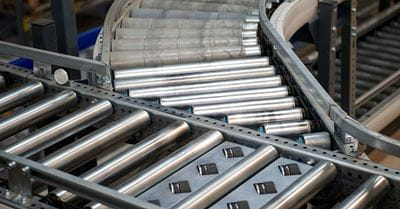Sortation Systems | Las Vegas

Raymond West supplies a full range of conveyor and automation products, including all types of sortation solutions.
To speak with a Raymond automation expert, phone us at 702-651-6480
Are you thinking about a sortation system for your Las Vegas Valley warehouse, distribution center or production facility? The most popular types of sortation systems vary greatly in capability and expense. In this article we offer a high level overview of the advantages and drawbacks of the three most prominent types of sortation systems.
Cross-Belt Sorter & Tilt Tray Sorter
Cross-belt and tilt-tray sorters offer similar functionality and are oftentimes associated when discussing sortation mechanization. However, they are quite different solutions.
Tilt-tray sorters are made up of trays mounted to carts that are transported on a continuous-loop conveyor. Products are put into the trays at one or more induction stations on the loop via manual or automated processes. When an item reaches its sorting destination, the tray that is transferring it tilts and dumps the product toward a chute.
Cross-belt sorters are powered belt conveyors mounted to carts operating on a continuous conveyor loop. Comparable to tilt-trays, cross-belt sorters transfer items onto a chute when they reach the proper sorting destination.
Advantages: Cross-belt and tilt-tray sorters provide the highest sorting rate and can handle a wide range of product types as opposed to other sortation solutions. They are a terrific option for operations that handle a wide variety of SKUs. These kinds of systems are likewise reasonably quiet and allow a more pleasant workplace for warehouse workers.
Disadvantages: The speed, capability and versatility or these sorters come at a price-- they are some of the most expensive sortation solutions available.
Shoe Sorter
Sliding shoe sorters use a "shoe" system connected to the conveyor surface that pushes and diverts products onto a secondary, after-sort conveyor. Shoe sorter systems receive goods from a single flow of items that may be a combined feed from numerous upstream locations of a warehouse. These kinds of sortation systems are widely utilized in shipping applications.
Advantages: Sliding shoe sorter systems enable a fairly high peak rate, often several hundred products per minute, depending on the product weight and dimensions. In addition, a wide range of items can be processed due to the simplicity and versatility of a positive divert system.
Disadvantages: Shoe sorters are more expensive than other options like pop-up wheel sorters. Likewise, divert areas are not readily movable, making the system difficult and expensive to reconfigure. These systems also generate more decibels than tray or belt systems and are accordingly not as worker-friendly as other styles of sorters.
Pop-up Wheel Sorter
Pop-up wheel sorters are a popular choice due to the fact that they are fairly inexpensive and simple to implement. Wheels or rollers are integrated with a belt conveyor. When an item has to be diverted, the wheels quickly rise up to shift units at an angle to an alternate, downstream conveyor.
Advantages: Pop-up wheel sorters are modular, so segments can be rapidly added or removed when the line requires modification. These systems can likewise be considerably less costly than other sorter choices.
Disadvantages: These types of sorters provide significantly less performance and capability than shoe, cross-belt or tilt-tray alternatives. They will undeniably increase productivity, yet may not maximize total output like other options. Because pop-up systems don't use a positive divert, the types of items they can handle are narrowed.
Automated Sortation Systems Near Me
If you'd like more guidance on sortation choices, phone an automation specialist at Raymond West today!
Raymond West
2555 E. Washburn Rd.
North Las Vegas, Nevada 89081
Phone: 702-651-6480

